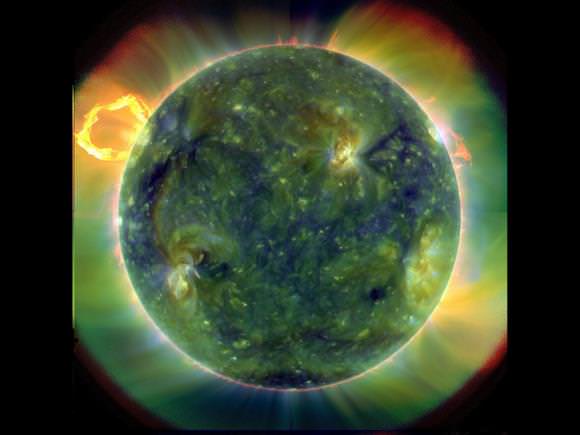[/caption]
NASA's newest solar satellite is officially open for business and all we can say is, "Wow!" The Solar Dynamics Observatory (SDO) released its "first light' images on Wednesday, showing incredible views of the sun, with extreme close-ups, never-before-seen detail of material streaming outward from sunspots and high-resolution looks at solar flares across a wide range of ultraviolet wavelength.
"These initial images show a dynamic sun that I had never seen in more than 40 years of solar research," said Richard Fisher, director of the Heliophysics Division at NASA. "SDO will change our understanding of the sun and its processes, which affect our lives and society. This mission will have a huge impact on science, similar to the impact of the Hubble Space Telescope on modern astrophysics."
SDO launched in February and has been billed as the "Crown Jewel" of NASA's fleet of solar observatories. This technologically advanced spacecraft is able to take images of the sun every 0.75 seconds and daily send back about 1.5 terabytes of data to Earth — the equivalent of downloading 380 full-length movies every day. The following graphic compares the capabilities of SDO with other missions and resolutions.
[caption id="attachment_63432" align="aligncenter" width="580" caption="This image compares the relative size of SDO's imagery to that of other missions. Credit: NASA"]
[/caption]
Serendipitously, shortly after the instruments opened their doors, our recently quiet Sun began to get a little more active. The video below was created from data from the Atmospheric Imaging Assembly, a group of four telescopes designed to photograph the sun's surface and atmosphere. This data is from March 30, 2010, showing a wavelength band that is centered around 304. This extreme ultraviolet emission line is from singly ionized Helium, or He II, and corresponds to a temperature of about 50,000 degrees Celsius.
This movie captures only a fraction of SDO's imaging capabilities. It shows the Sun's magnetic field followed by only four of SDO's 12 imaging wavebands. You'll see an eruption, flare, and dimming (dark regions evacuated by the eruption) by observing the event in several different layers of the atmosphere. If you're wondering why the movie doesn't show all 12 layers at full resolution it's because at high-res the movie would be nearly a third of a gigabyte in size.
The Helioseismic and Magnetic Imager maps solar magnetic fields and looks beneath the sun's opaque surface. HMI was undergoing a series of adjustments when it captured an eclipse of sorts. SDO's view was partially blocked by the Earth. At the edges of the shadow, the Sun's shape bends, due to the light's refraction by the Earth's atmosphere. SDO will have two "eclipse seasons" each year, when the orbit of SDO will intersect the Sun-Earth line.
For more images and a high-res version of the top image, see the
SDO website.
Just remember -- this is only the beginning of SDO's mission!
Source:
NASA
 Universe Today
Universe Today
